6/25/2012
Color Them SOLD
Chris Beytes, Jennifer Zurko & Ellen C. Wells
Spring Trials (Pack Trials, for those of us who still prefer that term) used to just be about genetics and showing off how your new petunia was 3 centimeters shorter and five days earlier than the competition’s. Then, around 1994, something happened called marketing. It might be said to have started with Bingo pansies and the Jones family and “Rally Round Fall Prophets,” and then Goldsmith partnered with Benjamin Moore paints to color-coordinate doors and windows with Goldsmith flowers. Then Proven Winners introduced branding, the late Kathy Pufahl introduced amazing mixed containers, Bill Calkins and I raved over yellow “caution” tape as the next great POP (Kieft Seeds, 2007) and the rest is history. Pack Trials seem to have become more about “show” and less about “grow.”
Not this year.
It’s safe to say that, while trial displays have retained a level of display and marketing acumen required of professional companies, Spring Trials was primarily about the plants.
Evidence:
- There was only one new brand introduced (HGTV HOME Plant Collection).
- We can’t recall a single new pot, tag or POP effort (except from the pot, tag and POP people, whose business it is to create that stuff).
- Mixed containers were evident, but not over the top. Big monoculture pots ruled the displays.
- Few trials had obvious “themes.” We knew why we were there: new varieties.
- We came up almost empty handed when searching for clever display ideas we could steal for Green Profit’s Cheap Tricks section.
Of course, there were exceptions:
- Ball’s corporate theme was “The Art of Plants,” with various styles of artwork used to highlight different breeding divisions and introductions.
- Dümmen’s theme was “Great Balls of Fire” for their new ivy geranium series; they channeled Jerry Lee Lewis via variety tags shaped like 45-rpm records.
- Pacific Plug & Liner made bench-top travelogue-style vignettes for five different introductions.
- Golden State Bulb Company created displays showing both seasonal and mixed container uses for their calla lilies.
Otherwise, most displays and signage focused on the specific attributes or benefits of the new genetics.
Speaking of which, a theme we heard at more than one trial was “eco” plants, meaning varieties that can be grown with fewer inputs (light, temperature, space, PGRs, etc.) than you might normally use for that crop, hence saving you money. Takii went so far as to refer to their new Trilogy petunia as an “eco-tunia.” We think the eco message is a good one, because while “sustainability” as a media buzzword is out, sustainability as a business philosophy is key to your survival. There’s no extra margin for wasted water, energy or chemicals. And remember, happy employees are productive employees!
A note on impatiens. Yes, there was talk of the impatiens downy mildew (IDM) issue, especially among growers from Florida, where the disease raised its ugly head early this spring. A few breeders used the opportunity to point out other shade-loving alternatives, such as begonias (of which there were a plethora of new intros, by the way). New Guinea impatiens are another option. But for the most part, nobody pushed overly hard to capitalize on the disease or try to displace
I. walleriana. Now we just need a breeder to come up with an IDM-resistant impatiens variety!
Lastly, color. It’s still what sells, and it was in tremendous abundance. In fact, much of our coverage revolves around the most colorful new introductions, whether series or one-offs. After all, if it looks great in a photo, we’re more likely to put it in the magazine.
So, all that said, here’s a look at breakthroughs, new series, a couple of specific categories that were especially busy, and more. Over on the
Green Profit side, you’ll find introductions geared especially toward retailers.
Click HERE to see them.
And lest you don’t see a category of interest to you here, next month we’ll be covering perennials, potted plants, mums (pot and garden), marketing ideas and anything else we missed, forgot, neglected or ignored.
Nifty Notables
These varieties had the crowds buzzing up and down the coast.
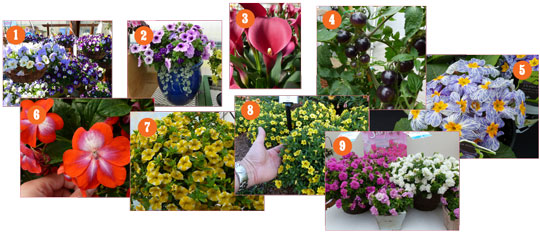
1. Pansy Cool Wave (PanAmerican Seed) A true trailing pansy had people taking notice…and being part of one of the most popular plant brands doesn’t hurt either. This new addition to the Wave family is the first on the market to completely cover the container, trailing and cascading as it grows. Claire Watson, product manager for Ball Horticultural, said the goal was to introduce a whole new class. They’re recommending 105-plugs to get more branching and PGRs aren’t required at the plug stage. Hanging baskets and 6-in. pots are ideal, but it will spread 12 to 24 in. when planted 12-in. apart in the landscape. The series is starting with four colors—White, Yellow, Violet Wing and Frost (both pictured here)—and a mix.
2. Synergy Mixed Combo Program (Ball Seed) The first-ever seed and vegetative mixed combination program with single-stick liners, this program is the brainchild of the Ball Ingenuity division of Ball Seed. They’ve been working for a few years on trials and collecting research on which varieties grow well together. Kevin Roethle said they started with 290 possible combinations and whittled it down to 10 for the first year of introduction. Growers have a handy pre-made combination of unique varieties for 8 to 10-in. hanging baskets, gallons and 6-in. pots.
3. Calla Callafornia Red (Golden State Bulb) Part of a new medium-sized series that’s ideal for pots because of its compact habit, this variety is loaded with bright pink flowers. They said no one else on the market has this color.
4. Tomato Indigo Rose (Plug Connection) One of the exclusive cherry tomatoes from Plug Connection included this variety with very dark-colored fruit. The first high antioxidant tomato, it’s not as sweet flavor-wise, but it produces loads of fruit and huge plants in just 16 weeks.
5. Primula Blue Zebra (Hort Couture) One of funkiest plants we saw this year! The blue pattern literally looked like someone drew on the petals with a ballpoint pen. Bred in Belgium, this is the first seed variety in the Hort Couture line. Obviously ideal as a potted plant, the trick will be how to market this eye-catching plant that really calls for its own endcap or display. You can’t stick this with the rest of your primulas. >>>
6. Impatiens Patchwork Cosmic Orange (Ball FloraPlant) This series of
Impatiens walleriana is called Patchwork because each color in the series features an interesting color pattern. We felt the most unique was Cosmic Orange (pictured), but all three new varieties offer something really different for the shade.
7. Calibrachoa Superbells Lemon Slice (Proven Winners) Splashed all over their Spring Trials book and part of P. Allen Smith’s Platinum Collection, it’s like two different plants in one. From far away, it looks like a yellow calibrachoa, but when you get closer that lemon-and-white pattern pops out. A unique, stable color never before seen in calibrachoa, it’s also more tolerant of higher pH levels. John Gaydos said many yellow-flowered plants are susceptible to iron chlorosis, but not this one. The mounding habit is great for hanging baskets.
8. Calibrachoa Calipetite Series (Sakata) Chris said he saw this new series at Costa’s trials in Florida (left) and they made a beautiful, tidy mound covered with flowers. Screened against a pH of 9, they passed the high tolerance test, plus they’re daylength neutral. Each variety is uniform in flower response, blooming in 8-hour days and no PGRs are required. A great border plant or interesting container plant. Includes five colors: White, Red, Yellow, Blue and Pink.
9. Petunia Surfinia Summer Double (Suntory) The folks at Suntory were very excited about this new series, which they say is a double petunia series that actually performs well in extreme conditions. All three colors—Rose, White and Pink—form a tight, mounded habit that withstands the hottest heat and the heaviest downpours. Recommended for pots, hanging baskets and window boxes.
New Series
We love one-off novelties and we love additions to existing lines. But best of all we love new series - they show that breeders are still hard at work developing multiple colors of good genetics. And while series have been a staple of seed breeding for years, we’re seeing more and more series in vegetative varieties, too. Here’s just a sampling of new series for 2013.
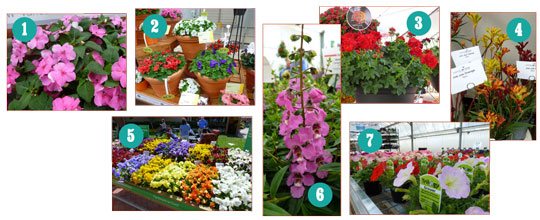
1. Impatiens Tumbler (Syngenta) Tumbler is one of six new series introduced by Syngenta for 2013. As its name implies, it’s a spreading type of seed impatiens. They say it has “extreme” vigor, with three 288-plugs making a nice 10-in. hanging basket instead of the usual five to seven plugs. The series starts with eight colors. Pink is pictured.
2. Petunia grandiflora Duvet (Syngenta) “Your grandmother’s petunia, but updated and modernized.” That’s how Duvet was described to us. We like that breeders haven’t forgotten good old grandifloras. Duvet (ask your grandmother what a duvet is) starts with five colors.
3. Ivy Geranium Great Balls of Fire (Dümmen) When you design your entire trial theme around a series, it should be a good one, and this ivy geranium from Dümmen looks to deliver the goods, as it’s been tested and selected in Florida and Texas for heat tolerance and edema resistance. The series starts with seven colors. Pictured: Dark Red.
4. Anigozanthus Joe Joe (GreenFuse Botanicals) This cute and fuzzy kangaroo paw series is more compact than Kanga, and much earlier (two weeks). Starts with three colors: Red, Orange and Yellow. >>>
5. Pansy Spring Matrix (PanAmerican Seed) Matrix is PanAm’s standard pansy series, which does fine for typical pansy summer production and fall sales. If you want early spring pansies, the new Spring Matrix series is bred for the shorter days and cooler conditions of winter and spring growing. The 17-color series (and five mixes) has a tight bloom window among colors. In PanAm’s trial, Spring Matrix was noticeably earlier than Matrix.
6. Angelonia Serenita (PanAmerican Seed) Serenita is a more compact version of Serena, PanAmerican’s breakthrough seed angelonia. It needs few or no PGRs, and is great for hot, humid climates like Florida. Comes in four colors and a mix. Pictured: Lavender Pink.
7. Petunia Trilogy (Takii) A new F1 seed petunia series that Takii calls an “eco-tunia” because it has characteristics that are critical to all three market segments: grower, retailer and consumer. With a habit that’s between a regular and a spreading petunia, Trilogy requires fewer inputs, has a long shelf life at retail and gives consumers long-season, tidy color. Grows to 15 in. tall and 30 in. wide, and starts with seven colors. >>>
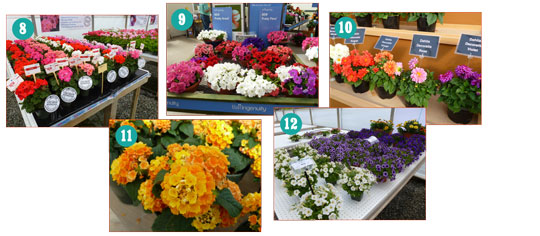 8. Geranium Nano (Hem Genetics)
8. Geranium Nano (Hem Genetics) Nano means “dwarf” in Greek, which gives you the idea that this is a compact series. Hem says it’s for the grower looking for cost control through fewer inputs and high-density production in 4 to 5 in. pots. Grows to 8 to10 in. in the garden. Shown as an experimental last year, Nano starts with seven colors and a formula mix.
9. Petunia Pretty Grand, Pretty Flora (Ball Seed) More activity in good, old-fashioned seed petunias! Pretty Grand (grandiflora, obviously) and Pretty Flora (you get one guess) are Ball Seed Exclusives from Ball Ingenuity that require half the rate of your normal petunia PGR regime, they say. Six strong colors in each series.
10. Dahlia Decoretta (Danziger) The Decoretta series has a compact habit that’s good for quarts and small pots. It comes in five vivid colors: Orange, Scarlet, Violet, White and Yellow.
11. Lantana Little Lucky (Ball FloraPlant) Yet another one with a descriptive name, i.e. “Little” meaning it’s a more compact version of Lucky. You can grow them pot-tight; for consumers, it solves the problem of “crazy” plants in the landscape. Grows to 8 to 10 in. tall and 15 in. wide in the garden, and comes in four colors. Peach is pictured.
12. Mini Petunias Vivini (Florensis) This Dutch breeder has some excellent petunia genetics (such as their Glow series), and Vivini brings a mini to the line. Starts with three colors: White, Violet Vein and Blue.
Bring on the Begonias!
This was the year of new begonia introductions, ranging from the classic to the crazy.
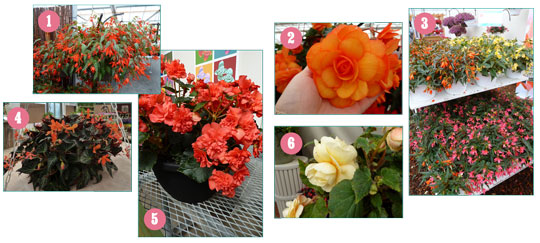 1. B. boliviensis Santa Cruz Sunset (Benary)
1. B. boliviensis Santa Cruz Sunset (Benary) The first
boliviensis from seed, this F1 hybrid takes the same conditions as its vegetative counterparts. It starts upright, then cascades to make a lovely basket or container, similar to a tuberous begonia. Being a seed type, it’s very cost effective and doesn’t need pinching. Seed germination is 85 to 90%.
2. Arcada Series (Ecke Ranch) If you’re into big and beautiful, this is the begonia series for you. A tuber-hybrida type, these plants need light to flower, but once they get going, they’re very vigorous. An ideal hanging basket plant for the grower/retailer because of its unique habit and flower form, it works well in part shade areas. However, in warmer climates, it needs to be placed in full shade. Includes seven colors: Apricot Bicolor (pictured), Light Pink, Orange, Pink, Scarlet, White and Yellow.
3. Crackling Fire Series (Suntory) Another
boliviensis type, this new series can produce in a 4-in. pot—unlike others within the species. Bred in Japan, its compact habit allows for easier shipping (i.e. less breakage) and all of the colors feature saw-toothed leaves. The four colors are: Pink, Creamy Yellow, Orange and White.
4. Sparks Will Fly (Burpee Home Gardens) A fun name for a fun-looking hybrid begonia. Very dark-bronze foliage contrasts nicely with the bright orange blooms. Easy to grow and finishes fast.
5. Begonia-mania! (Ball Seed) The Ball Ingenuity division of Ball Seed had an entire display of all things begonia…so much that they were calling it “Begonia-mania.” The Fire Balls program of heimalis begonias (pictured), the new Bon Bon series, Million Kisses Honeymoon and the Bliss series of double-flowered begonias are all exclusive to Ball Seed. Obviously, their big focus on this popular crop is that it’s great for the shade.
6. Champagne (GreenFuse) A tuberous-type that’s a vigorous grower with huge peach-colored blooms. Another good retail grower item.
Petunias A-Plenty
As an industry, we must love petunias: At our count, there were at least 25 different series and individual color introductions in the category. We covered many of them in the “New Series” section; here are some additional intros in this very busy category.
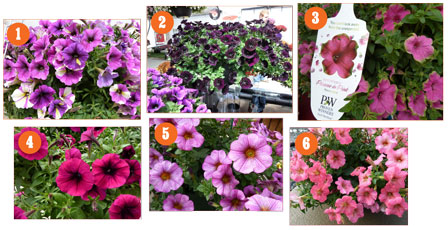 1. Blue A Fuse (Burpee Home Gardens)
1. Blue A Fuse (Burpee Home Gardens) Definitely a winner in the “Cool Names” category, this variety has three different colors on its blooms to make an instant “mix” regardless if it’s combined with other plants or solo.
2. Potunia and Surprise Additions (Dümmen) The Plus sub-series of Potunias means the plants are 20 to 25% more vigorous. Dümmen introduced three new Plus colors: Banana, Strawberry Ice and Purple, and a really interesting deep, deep purple petunia from the Surprise series called Midnight Cowboy (pictured).
3. Supertunia Additions (Proven Winners) Three new colors have been added to the popular series, including Picasso in Pink—which is similar to Pretty Much Picasso, but it’s less vigorous and more compact. There’s also new Pink Charm and Watermelon Charm.
4. Shock Wave Deep Purple (PanAmerican Seed) An important addition to the Wave family, Deep Purple matches the rest of the series in earliness to flower and is a more vibrant color than the original Purple. It’s also the only small-flowered series from seed.
5. SuperCal Petchoa Additions (Sakata) Bred to blend the best traits of petunias and calibrachoa, Sakata added three new colors, bringing the series to 11 colors. Artist Rose (pictured) was the most interesting with its purple veining; Blushing Pink and Violet are also new. The message here is that these petchoas don’t have pH problems and the leaves aren’t sticky. And for the first time, Sakata is offering branded pots for the SuperCal series.
6. Glow Rose Blush (Florensis) A nice early pink for hanging baskets, this addition is the 15th color in the series. But check with your broker because not all of them are available in the U.S.
Tumble & Flow
It was also the year of cascading, trailing plants, which provides even more “spillers” for combinations and hanging baskets.
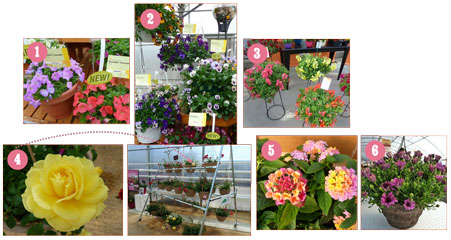 1. Petunia Picobella Cascade series (Syngenta)
1. Petunia Picobella Cascade series (Syngenta) This new series includes seven colors and a mix with a nice small habit that flows over the container. A good seed-combo choice and an alternative to calibrachoa, the plants hold up longer at retail because of its better branching habit than other varieties in the milliflora class.
2. Pansy Wonderfall series (Syngenta) Also from Syngenta, these trailing, vigorous plants feature true pansy-sized flowers and you only need three plugs max to finish a 10-in. hanging basket. It also works well in the landscape. Starting with five colors, the series will eventually be comprised of eight to 10.
3. Snapdragon Candy Showers (Sakata) Although these plants have limited distribution through April 2013, we had to mention them because of the beautiful trailing color. Ideal for baskets and containers, Candy Showers is a great multiple cool-season plant for spring and fall. Includes five colors that bloom well under short days. >>>
4. Rose Balconia Collection (Greenheart Farms) The perfect product for consumers who don’t have room for shrub roses, but still want the beauty that a rose offers. And they were displayed on a neat new hanging basket A-frame from Cherry Creek Systems. Three new introductions with fun names: Solero (yellow, pictured), Chipotle (orange) and Pepita (pink.)
5. Lantana Santana series (Danziger) This lantana series was bred for hanging baskets and to serve as a groundcover in beds and landscapes. Like other
L. camara, it loves the heat and bounces back after a hard rain. Five new colors make up the series, but Banana Punch (pictured) was our favorite because of the mix of light pink, fuchsia and yellow.
6. Osteospermum Sun Brella (Greenex) A sub-series of Sunny, these plants have a trailing habit that’s slightly upright for a true mounded look. The Greenex crew said that the plants cascade from baskets, planters or even over walls. The series includes three colors: Corona (lavender, pictured), Pegasus (white) and Taurus (yellow).
Crazy with Color
No need to go into the details; these flower colors stand out on their own. (But we’ll give you the info anyway.)
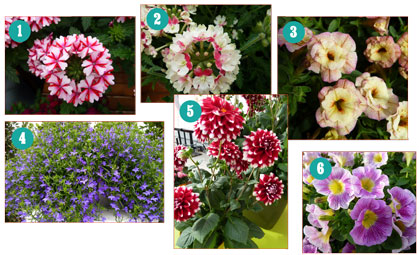 Verbena Lanai Additions (Syngenta)
Verbena Lanai Additions (Syngenta)
Last year, we saw the breeding breakthrough Twister Pink and to complement this unique variety are three new ones that offer unbelievable consumer appeal.
1.Candy Cane and
2.Vintage Rose have the same bicolor bloom patterns that stand out in pots and combos.
3. Calibrachoa MiniFamous Double Rose Chai (Selecta) Whether you love it or it makes you go “meh,” you can’t deny the really interesting veining pattern on this double calibrachoa. This plant was completely covered with these antique-looking blooms.
4. Lobelia Deep Blue Star (Westhoff) They’re calling it the deepest blue of any flower on the market … we’re calling it striking. Standing from a distance, the flowers of this lobelia appear to glow. (It helps that the entire plant was covered in blooms.) Nice, compact habit that grows up and then out of the container with an early flowering time.
5. Dahlia Starsister Double Crimson Picotee (Fides Oro) Through their acquisition of Oro Farms, Fides is introducing new lines of core crops with interesting colors. This dahlia series, bred by Hem Genetics, is a more upright type than others on the market. The blooms are fully double with a stable color pattern.
6. Petunia Marvel Beauty Blueberry (Danziger) This one could have also gone in the “New Series” or “Petunias A-Plenty” categories, but the color is just way too cool so we put it here. There’s also a Raspberry with pink veining to complement its purple partner.
No-Pinch Poinsettias
At Takii’s trials stop, Dr. Jim Barrett from the University of Florida talked about the research he’s conducted using OHP’s Augeo PGR to see if growers could save labor and time by avoiding pinching on poinsettias. Dr. Barrett did say there are variations on some varieties and Prestige is the poinsettia that seems to respond the best.
Get more details by watching our video at
http://tinyurl.com/jimbarrettandaugeo.
Wave’s Makeover
Since 1995, the Wave brand of petunias has graced retail benches. According to PanAmerican Seed, 72% of consumers look for the Wave brand in the recognizable pink pots and packs.
At Spring Trials, PanAmerican Seed unveiled some exciting additions to the Wave family. The new Cool Wave Pansy series will be ready for consumers next spring, but also for 2013 is a new look for the brand across all of the different sub-series. Wave, Easy Wave, Tidal Wave and Shock Wave will have new logos on new POP and signage. Of course, the same pink pots will still be available.
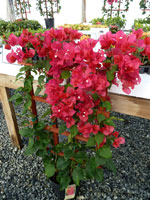 Also Spotted …
Also Spotted …
If you were looking for bougainvillea during Spring Trials (and why wouldn’t you be?), the only place to find it was at Vista Farms’ exhibit at the Speedling stop. Vista Farms’ Jerome O’Neill said it was their first time at the trials, but they’ve been in business for about 24 years. They produce tropical plant liners in Puerto Rico, most of which is bougainvillea. If you’re looking to offer something different that will charm those finicky consumers, you should give Vista Farms a call.
The Name Game
How long does it take to come up with these plant names? We’re not sure. But we can guess that perhaps the breeders and product managers enjoy lots of Mountain Dew and Pop Rocks right before their brainstorming meetings. How else would they come up with these clever, kooky-and sometimes tasty-plant monikers.
Flic Flac (Geranium series from Schwartz Nursery)
ColorBlaze Keystone Kopper & Marooned (Coleus from Proven Winners)
Scampi (Scaevola series from GreenFuse)
Glamouflage (Petunia from Hort Couture)
BBQ On Fire (Gerbera mix from Florist Holland—and Beytes’ favorite)
Hot Joker, Hot Taco & Hot Salsa (Peppers from Greenex)
Pardon My Pink & Pardon My Purple (Monarda from Walters Gardens/Proven Winners)
Pop ‘N Polish (Petunia series from HGTV HOME Plant Collection)